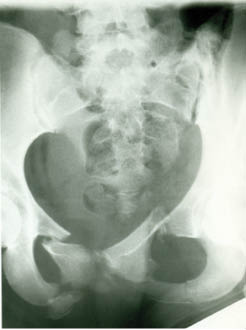 [Case History]
[Case History]This patient presents following severe trauma to the pelvic region after a motorcycle accident.
Diagnosis: This patient has bilateral fractures of the superior and inferior pubic rami which has been referred to as a STRADDLE FRACTURE. Fortunately, this patient had no injury to the bladder, as bladder trauma is often present with fractures such as this. Of incidental notation is a bilateral transitional segment at the lumbosacral junction with a unilateral accessory joint articulation.
Straddle Fractures
The straddle fracture or comminuted fracture of the pubic arches is the most common type of unstable fracture of the pelvis. This double vertical fracture involves both superior pubic rami and ischiopubic junctions bilaterally. The central fracture fragment is usually displaced posterosuperiorly, placing pressure upon the ventral surface of the bladder. Twenty percent of these patients have bladder rupture and urethral tear which may require diagnosis via urethrography and cystography.1
Bucket-Handle Fracture
The bucket-handle fracture represents a fracture through the superior pubic ramus and ischiopubic junction on the side opposite the oblique force of impact to the pelvis. A fracture or dislocation of the sacroiliac joint on the side of impact is part of the injury. This fracture is usually the result of an automobile or auto/pedestrian accident. The pubic component of the fracture is usually displaced inward and superiorly. Associated injuries to the abdominal viscera, head and thorax may be present.1
Avulsion Fractures
Symphysis Pubis. Severe injuries of the major adductor muscles cause a tearing of bone from the superior or inferior pubic rami near the pubic articulation. This injury is common in soccer players.
Ischial Tuberosity (Rider’s Bone). This type of fracture represents an avulsion of the secondary growth center (apophysis) for the ischial tuberosity as a result of a forceful contraction of the hamstring group of muscles. With healing, an unexplained overgrowth of the avulsed apophysis occurs, often leaving a wide radiolucent gap between the avulsed fragment and the parent ischium.
This overgrowth may be the effect of hyperemia upon the ischial apophysis. Occasionally, the avulsed ischial apophysis may assume a size larger than the parent ischium. This large overgrowth should not be confused with an extraosseous neoplasm. Usually, the patient’s history of a previous severe hamstring injury and the fact that the lesion is asymptomatic secures the proper diagnosis.
These fractures are seen most commonly in cheerleaders and hurdlers. The residual bony fragment has been called “rider’s bone,” because a high percentage of these lesions occur in horseback riders as a result of chronic stress.
Dr. Terry R. Yochum is a second generation chiropractor and a Cum Laude Graduate of National College of Chiropractic, where he subsequently completed his radiology residency. He is currently Director of the Rocky Mountain Chiropractic Radiological Center in Denver, Colorado, and Adjunct Professor of Radiology at the Southern California University of Health Sciences, as well as an instructor of skeletal radiology at the University of Colorado School of Medicine, Denver, CO. Dr. Yochum can be reached at 1-303-940-9400 or by e-mail at [email protected]
Dr. Alicia M. Yochum is a third generation chiropractor and 2011 Suma Cum Laude Graduate of Logan College of Chiropractic, as well as a Registered Nurse. She is starting her Radiology Residency at Logan College in April 2012. She can be reached at [email protected].
Reference: 1.Yochum TR, Rowe LJ: Essentials of Skeletal Radiology, 3rd ed., Williams & Wilkins, Baltimore, Maryland, 2005.
